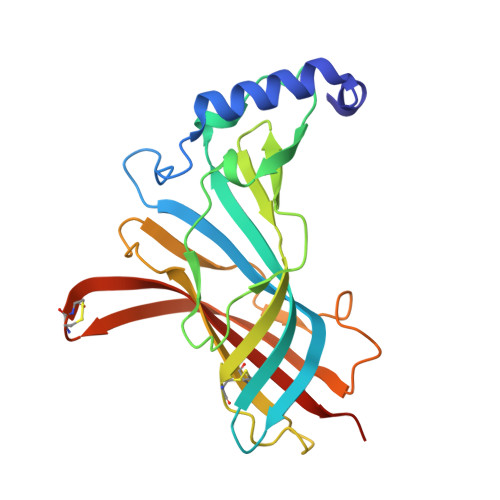Substituted 2-Aminopyrimidines Selective for alpha 7-Nicotinic Acetylcholine Receptor Activation and Association with Acetylcholine Binding Proteins.
Kaczanowska, K., Camacho Hernandez, G.A., Bendiks, L., Kohs, L., Cornejo-Bravo, J.M., Harel, M., Finn, M.G., Taylor, P.(2017) J Am Chem Soc 139: 3676-3684
- PubMed: 28221788
- DOI: https://doi.org/10.1021/jacs.6b10746
- Primary Citation of Related Structures:
5J5F, 5J5G, 5J5H, 5J5I - PubMed Abstract:
Through studies with ligand binding to the acetylcholine binding protein (AChBP), we previously identified a series of 4,6-substituted 2-aminopyrimidines that associate with this soluble surrogate of the nicotinic acetylcholine receptor (nAChR) in a cooperative fashion, not seen for classical nicotinic agonists and antagonists. To examine receptor interactions of this structural family on ligand-gated ion channels, we employed HEK cells transfected with cDNAs encoding three requisite receptor subtypes: α7-nAChR, α4β2-nAChR, and a serotonin receptor (5-HT 3A R), along with a fluorescent reporter. Initial screening of a series of over 50 newly characterized 2-aminopyrimidines with affinity for AChBP showed only two to be agonists on the α7-nAChR below 10 μM concentration. Their unique structural features were incorporated into design of a second subset of 2-aminopyrimidines yielding several congeners that elicited α7 activation with EC 50 values of 70 nM and K d values for AChBP in a similar range. Several compounds within this series exhibit specificity for the α7-nAChR, showing no activation or antagonism of α4β2-nAChR or 5-HT3AR at concentrations up to 10 μM, while others were weaker antagonists (or partial agonists) on these receptors. Analysis following cocrystallization of four ligand complexes with AChBP show binding at the subunit interface, but with an orientation or binding pose that differs from classical nicotinic agonists and antagonists and from the previously analyzed set of 2-aminopyrimidines that displayed distinct cooperative interactions with AChBP. Orientations of aromatic side chains of these complexes are distinctive, suggesting new modes of binding at the agonist-antagonist site and perhaps an allosteric action for heteromeric nAChRs.
Organizational Affiliation:
Department of Pharmacology, Skaggs School of Pharmacy & Pharmaceutical Sciences, University of California, San Diego , La Jolla, California 92093-0650, United States.

















